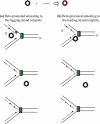RecA-independent single-stranded DNA oligonucleotide-mediated mutagenesis
- PMID: 20711416
- PMCID: PMC2920528
- DOI: 10.3410/B2-56
RecA-independent single-stranded DNA oligonucleotide-mediated mutagenesis
Abstract
The expression of Beta, the single-stranded annealing protein (SSAP) of bacteriophage lambda in Escherichia coli promotes high levels of oligonucleotide (oligo)-mediated mutagenesis and offers a quick way to create single or multiple base pair insertions, deletions, or substitutions in the bacterial chromosome. High rates of mutagenesis can be obtained by the use of mismatch repair (MMR)-resistant mismatches or MMR-deficient hosts, which allow for the isolation of unselected mutations. It has recently become clear that many bacteria can be mutagenized with oligos in the absence of any SSAP expression, albeit at a much lower frequency. Studies have shown that inactivation or inhibition of single-stranded DNA (ssDNA) exonucleases in vivo increases the rate of SSAP-independent oligo-mediated mutagenesis. These results suggest that lambda Beta, in addition to its role in annealing the oligo to ssDNA regions of the replication fork, promotes high rates of oligo-mediated mutagenesis by protecting the oligo from destruction by host ssDNA exonucleases.
Figures

Similar articles
-
Probing cellular processes with oligo-mediated recombination and using the knowledge gained to optimize recombineering.J Mol Biol. 2011 Mar 18;407(1):45-59. doi: 10.1016/j.jmb.2011.01.030. Epub 2011 Jan 19. J Mol Biol. 2011. PMID: 21256136 Free PMC article.
-
Enhanced levels of lambda Red-mediated recombinants in mismatch repair mutants.Proc Natl Acad Sci U S A. 2003 Dec 23;100(26):15748-53. doi: 10.1073/pnas.2434959100. Epub 2003 Dec 12. Proc Natl Acad Sci U S A. 2003. PMID: 14673109 Free PMC article.
-
Directionality of DNA replication fork movement strongly affects the generation of spontaneous mutations in Escherichia coli.J Mol Biol. 2001 Apr 13;307(5):1195-206. doi: 10.1006/jmbi.2001.4557. J Mol Biol. 2001. PMID: 11292335
-
Targeting DNA mismatch repair for radiosensitization.Semin Radiat Oncol. 2001 Oct;11(4):300-15. doi: 10.1053/s1053-4296(01)80067-9. Semin Radiat Oncol. 2001. PMID: 11677655 Review.
-
Structure and mechanism of the Red recombination system of bacteriophage λ.Prog Biophys Mol Biol. 2019 Oct;147:33-46. doi: 10.1016/j.pbiomolbio.2019.03.005. Epub 2019 Mar 21. Prog Biophys Mol Biol. 2019. PMID: 30904699 Free PMC article. Review.
Cited by
-
Recombineering in Non-Model Bacteria.Curr Protoc. 2022 Dec;2(12):e605. doi: 10.1002/cpz1.605. Curr Protoc. 2022. PMID: 36546891 Free PMC article.
-
Identification of new drug targets and resistance mechanisms in Mycobacterium tuberculosis.PLoS One. 2013 Sep 23;8(9):e75245. doi: 10.1371/journal.pone.0075245. eCollection 2013. PLoS One. 2013. PMID: 24086479 Free PMC article.
-
In vivo DNA assembly using common laboratory bacteria: A re-emerging tool to simplify molecular cloning.J Biol Chem. 2019 Oct 18;294(42):15271-15281. doi: 10.1074/jbc.REV119.009109. Epub 2019 Sep 14. J Biol Chem. 2019. PMID: 31522138 Free PMC article. Review.
-
Bacillus subtilis genome editing using ssDNA with short homology regions.Nucleic Acids Res. 2012 Jul;40(12):e91. doi: 10.1093/nar/gks248. Epub 2012 Mar 15. Nucleic Acids Res. 2012. PMID: 22422839 Free PMC article.
-
Replicative DNA polymerase δ but not ε proofreads errors in Cis and in Trans.PLoS Genet. 2015 Mar 5;11(3):e1005049. doi: 10.1371/journal.pgen.1005049. eCollection 2015 Mar. PLoS Genet. 2015. PMID: 25742645 Free PMC article.
References
Grants and funding
LinkOut - more resources
Full Text Sources
Other Literature Sources

